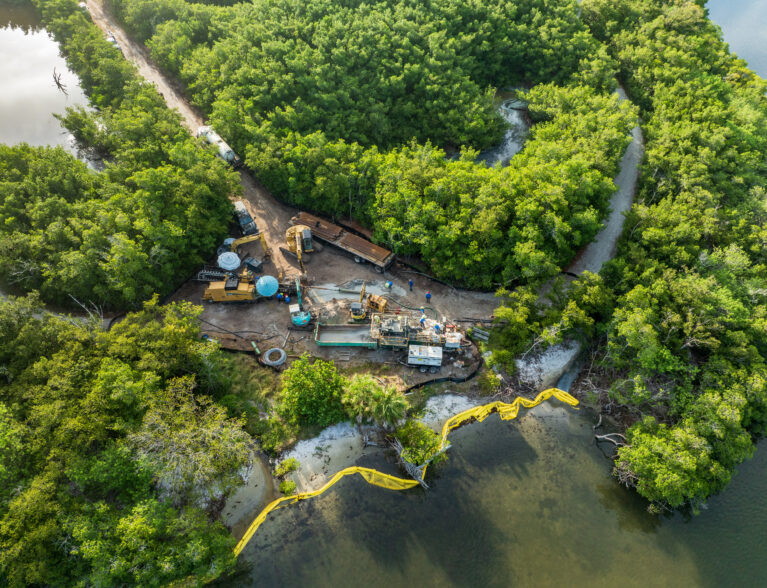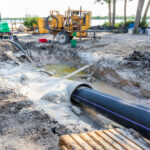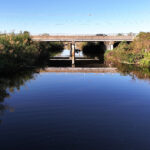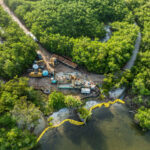
A remarkable piece of civil engineering now nearing completion will solve a problem that has plagued John’s Island for more than a decade – while saving the City of Vero Beach and its taxpayers more than $30 million.
It will also provide an amazing array of ecological benefits for the Indian River lagoon and estuary.
In a nutshell, the project will pull mildly polluted water from Vero’s main relief canal, pipe it a short distance to a redundant water plant built in the 1950s, purify the water, and then pump it via a new pipeline under the lagoon to John’s Island, where the sparkling commodity will keep golf courses and lawns lush and green.
Vero Beach is one of dozens of cities, counties and agencies required by the state’s Indian River Lagoon Basin Management Action Plan, or BMAP, to reduce the flow of nitrogen and phosphorous into the lagoon, where the chemicals feed harmful algae blooms.
“Building stormwater projects that would remove the 17,000 pounds of nitrogen per year this project removes would cost an estimated $34.2 million,” said Vero water and sewer department director Rob Bolton, who conceived of and mostly designed the new irrigation water project.
“Our cost on the project is less than $1 million and when it is complete in August, we will have met our BMAP requirements through 2035. We are ahead of most cities in this regard.”
Bolton said the project’s 17,000-pound nitrogen reduction figure was calculated in consultation with the Florida Department of Environmental Protection.
What makes this project remarkable is that besides slaking the John’s Island community’s thirst for 3 million gallons a day of clean irrigation water and providing Vero with a financial boost that will come in handy as the projected cost of the new sewer plant keeps rising, the project almost magically throws off ecological benefits at every stage.
It has pulled diverse elements of the community together in surprising ways, bypassing the long-simmering water war between Vero Beach and Indian River Shores while uniting city planners, environmentalists and the island’s most notable club community.
Major state water agencies have jumped onboard, too, providing an escalating series of grants as the project came into focus that total nearly $5 million the $13.5 million total projected cost.
“You don’t usually get grants to cover that kind of percentage,” Bolton said. “If you get 10 percent from the state, that is decent; 20 percent, and you are really doing well. In this case, we are getting more than 35 percent from St. Johns River Water Management District and FDEP because of the benefits to the lagoon and aquifer.”
“It is a good project,” said Ken Grudens, executive director of the Indian River Land Trust, which provided an easement at Bee Gum Point where the pipeline comes ashore on the island.
“This system is removing nitrogen form the lagoon, supplanting the use of sewage reuse water and reducing the need to use well water from the surficial aquifer on the island. It’s also reducing the flow of excess fresh water into the lagoon, which tends to throw the ecology out of balance.
“We have been talking to [other lagoon environmental groups] … throughout the process and everybody seems to be onboard. We haven’t seen any pushback.”
An attempt six years ago to send county irrigation water to John’s Island in a pipeline under the lagoon was strongly opposed by local environmental groups and blocked by the county commission “because it would have carried water high in nitrogen that would have damaged the lagoon if there was a leak,” Grudens said.
“In this case, it’s water that would have gone into the lagoon anyway, but filtered and cleaned up, so a leak would not hurt the ecosystem.”
“This time around we had the Clean Water Coalition and Indian River Neighborhood Association show up at City Hall to support the project,” said Bolton.
“We have been looking for an alternative water supply for 12 years,” John’s Island Homeowners Association general manager Mike Korpar told Vero Beach 32963.
“We have been using Vero Beach city reuse water that’s high in nitrogen along with well water.
The reuse supply fell short at times, and we don’t want to continue using well water for irrigation because it comes from the aquifer that provides drinking water. The quality of the well water is deteriorating, and we need to let those wells rest and recharge for future generations.
“Rob came up with the great idea of taking water out of the main relief canal, treating it and putting it in a pipeline that we are funding with help from the state. St. John’s River Water Management gave us a grant because the project is so good for the lagoon.
“Vero Beach is the first city on the East Coast of Florida to build something like this. It is very innovative and effective and will provide us with a more consistent, cleaner supply of water for irrigation.”
Korpar said that the John’s Island homeowners association will use 2,800,000 gallons of water per day on average to keep lawns and common areas green while the club, a separate entity, will use 200,000 gallons a day to water its golf courses.
Bolton conceived the project in the Covid-19 summer of 2020. The City Council signed off in September of that year. After preliminary design was complete, the city and John’s Island Water Management signed a memorandum of understanding in July 2021, in which the club community agreed to pay for the pipeline and consume a certain amount of water daily.
Further design and securing permits from FDEP, DOT, Indian River County, Indian River Shores and Florida East Coast Railway ate up another two years.
“It took almost a year to get the permit from the railroad to run the pipeline in their right-of-way,” Bolton said.
Building began at the end of 2023, with construction of an intake and pump station on the main relief canal behind the county government center. Two powerful new pumps costing about $40,000 apiece have the capacity to pull four million gallons of water daily from the canal, which is about 20 percent of the waterway’s 20-million-gallon flow, according to Vero Beach City Manager Monte Falls.
Those millions of gallons are laden with nitrogen and phosphorus from fertilizer and septic systems, so the withdrawal reduces the flow of harmful chemicals into the lagoon.
It also reduces the amount of freshwater that flows into the brackish waterway, which blends salt and fresh water into a unique marine environment that once was the most biologically diverse estuary in the United States.
“The ecological balance in the lagoon is based on a much smaller watershed that existed before the canals were dug,” said Grudens. “This project helps reduce the problem of too much freshwater.”
From the new intake, canal water is pumped 1,200 feet, under Aviation Boulevard, to a city water plant facility near the airport that was built the year Dwight Eisenhower was first elected president and once supplied all of Vero’s drinking water.
The existence of that plant was essential to Bolton’s plan.
“I looked at it and saw that it could easily be disconnected from the rest of the water system and used for this new purpose,” he said.
At the repurposed plant, the canal water will be dumped into legacy sand and charcoal filters that will extract nitrogen and other contaminants, then pumped by three new pumps costing $400,000 into an adjacent 2-million-gallon tank to create a steady supply reservoir.
The same powerful pumps will then pull the water out of the reservoir tank and push it through a new high-density polyethylene pipe that runs north along the railroad tracks to 41st Street, east along 41st to Indian River Boulevard, and then north along Indian River Boulevard to 45th Street. From there it goes east along 45th to Gifford Dock Park on the shore of the lagoon, dives down 80 feet, goes under the waterway and remerges at the Land Trust’s Bee Gum Point conservation property.
From there, the thick-walled pipe, which has an 18-inch exterior diameter and 16-inch interior diameter, extends to Fred Tuerk Drive, goes west along that road to Highway A1A and north along A1A to JI’s south gate, where it connects to the community’s irrigation water system.
The canal water ends up being dumped into four large ponds that the John’s Island system draws from to waterfront lawns and fairways.
At John’s Island, two more eco-benefits emerge. The purified canal water has much less nitrogen than the reuse water it will replace, which comes somewhat irregularly from the 17th Causeway sewer plant via an old pipeline. That means it can run off into the lagoon without harm.
The second benefit, which won a $1.2 million grant from FDEP, is a 1.5-million-gallon-per-day reduction in withdrawals from the aquifer that supplies Indian River County’s drinking water.
Bolton said the pipeline is 85 percent complete and slated to be operational by August. John’s Island will pay about 50 cents per thousand gallons of irrigation water, a figure calculated to pay for upkeep of the system and supply a small amount of revenue to Vero Beach but otherwise break even.
Accurate Drilling Systems out of LaBelle, Florida, ran the pipeline under the lagoon.
“It was really neat the way they did it,” Bolton said. “Scuba divers ran copper wires all the way from Gifford Dock to Bee Gum Point, which were used to create a magnetic field that guided the drilling heads.
“The system is very accurate going down and along the route but not as great coming up, so they drilled from both sides and then one drill head followed the other back out of the excavation.”
Rather than pulling dirt out of the pipe pathway like an auger drill, ADT’s drills used a clay lubricant to compact the soil 80 feet below the lagoon, creating a 30-inch passageway through which they pulled the 18-inch pipe.
Subaqueous drilling began in July and Grudens kept a watchful eye to make sure work at Bee Gum Point was complete before the migration and nesting season for thousands of water birds that inhabit the protected natural environment in winter.
Bolton provided detailed cost and revenue source figures for the project: The canal intake with new pumps cost $2.1 million; renovating the antique water plant was $1.2 million; design was $1 million; the pipeline was $8.5 million; and there was $250,000 in valve and other miscellaneous costs.
The costs will be paid by $4.9 million in state grants, $8 million from John’s Island Water Management, and $600,000 from the city. The city also contributed the existing water plant, filters and a section of pipeline.
“This was an opportunity for us to be good stewards and good neighbors,” said Falls. “We took a natural resource that wasn’t being used and repurposed it a way that helped John’s Island and the lagoon and the drinking water supply. John’s island needed that resource, and Rob found a way to supply it.”
Photos provided







